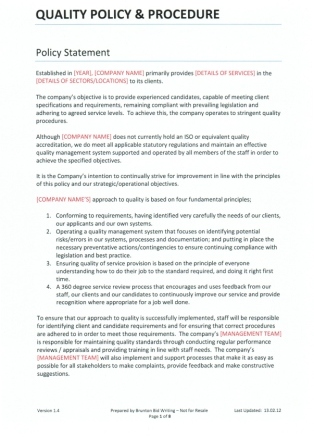
- #Quality Assurance Policy Template Manual Steps In
- #Quality Assurance Policy Template Full Support And

Quality Assurance Policy Template Full Support And
Evaluating objectively the performance of processes and work products against process descriptions, standards, and procedures Activities involved in performing quality assurance for processes include: Quality assurance plan template Define quality criteria Prepare quality. Implementing this process supports highquality delivery at all levels by providing visibility into and feedback on processes and their associated work products.quality assurance procedures and activities for improving or maintaining the. Once sound data management processes are established and operational, it is important to ensure that established processes are being executed as intended and delivering expected benefits, also known as process quality assurance. To achieve these objectives, full support and unreserved commitment of.
The table below depicts selected initial activity steps and indicates quality assurance considerations that can be applied: DQA Activity StepsConvene working group of experts across the patient demographic lifecycleDocumentation of current data quality issuesVerify if all relevant stakeholders were involvedReview list of current data quality issuesFinalize initial set of key patient demographic data elementsReview list and ensure that all identified data quality issues are aligned to one or more data elementsDefine thresholds and targets based on business needs and selected data quality dimensionsFor each data element, defined threshold (lowest acceptable quality) and target (aspirational level of quality)Verify relevant data elements thresholds and targetsReview quality dimensions applied and rationale providedReview thresholds and targets for relevanceIn organizations that have succeeded in evolving a quality-oriented culture ( See Data Quality Planning), the process quality assurance role can be performed completely by peers, and the quality assurance function can be an activity step in process performance. This process involves a number of activity steps and staff roles ( See Data Quality Assessment). For critical processes, a more formal approach may be employed periodically to ensure objectivity, including: audits by internal, separate quality assurance staff in-depth analysis of process execution as it is performed quality assurance reviews of work products and process checks added into activity steps to prevent failures.To consider an example of creating a quality assurance template for a data management process, take the case of an organization which is implementing its new data quality assessment process with the objective of improving the quality of patient demographic data. Less formal approaches, such as peer reviews, are appropriate to assist process performers day-to-day. Ensuring that any noncompliance issues are addressed.Objectivity in quality assurance evaluations is important to yield meaningful feedback and improvements, and it can be achieved by employing unambiguous criteria and independent evaluators. Providing feedback to staff and reporting to management about the results of quality assurance activities and
...

Quality Assurance Policy Template Manual Steps In
In such cases, standard measures and metrics clearly communicate performance expectations that support the overall objective of patient safety for participants in every related process, as well as fostering achievement of data quality objectives. The one-to-many relationships between standards and the implemented environment pose risks for any changes that may result in unanticipated negative impacts on the quality of patient data and ultimately on patient care.Standard process quality measures and metrics support the objective evaluation of the effects of process improvements, especially in a complex chain of linked activities where little informal communication may occur between the various stages of care. Data quality impacts (inputs and outputs)Establishing and adopting process standards, descriptions, and procedures is not enough to ensure that results are improved across the patient demographic data lifecycle. In this case there is a risk that process improvements in the registration process may result in more duplicate records inadvertently impacting downstream consumers of the data. However, the redundant steps may have been performed to reduce negative impacts on patient identity integrity. Without considering the quality of the process, the root issue may go undetected and result in repeated data cleansing by downstream consumers of the data.Alternatively, process quality issues may result from lower throughput of patients in the registration process, holding up the delivery of care due to redundant manual steps in the patient registration process.


 0 kommentar(er)
0 kommentar(er)
